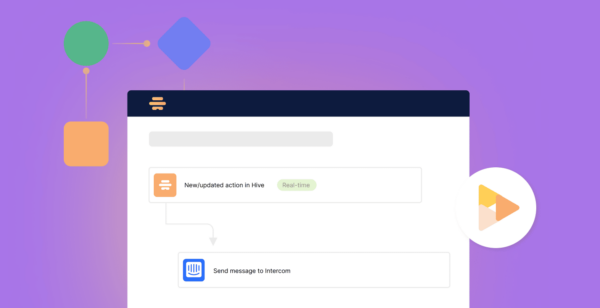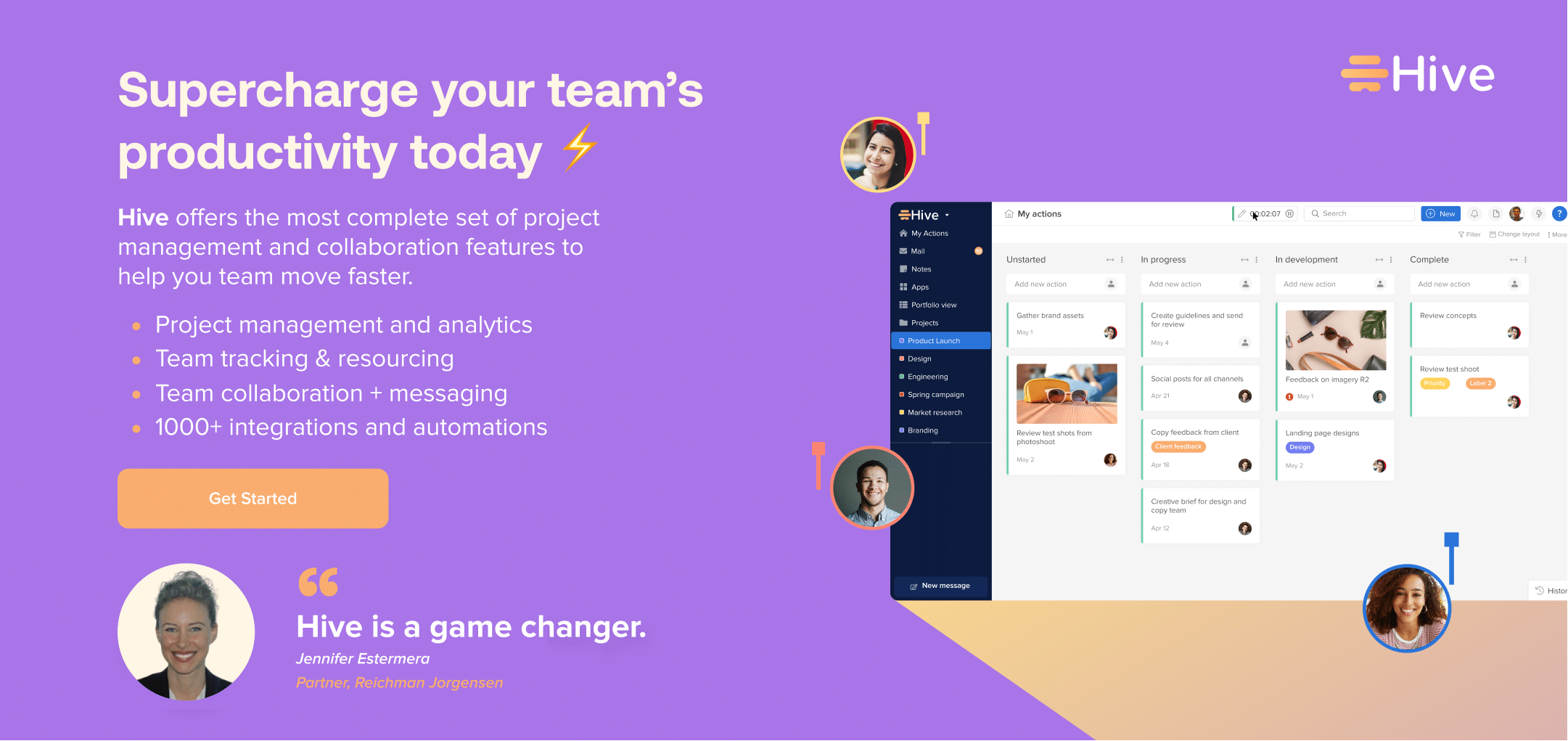At the end of the workday, there is one thing that brings everyone together. Regardless of industry, job title, or experience level, we all share one common goal: to get our work done, as soon as possible. Think about it. Do you know a single person who would turn down the opportunity to work faster?
When it comes down to it, we all work in order to live life the way we want. There are many other motivations for work, including personal fulfillment, the desire to make an impact, or even a genuine passion for what you do. But even so, 72% of people say they work to live, proving that work is often just a means to an end.
This is probably why so many people (including yourself, as you’ve clicked on this article) are interested in optimizing their workday. The more efficient you are at work, the sooner you can get back to your life. At Hive, we believe work life balance is totally possible. This is why we are sharing nine easy ways to get work done faster, leaving more time for the things you love.
1. Know your strengths and weaknesses.
If you want to work faster, you must understand your own personal strengths and weaknesses. This will help you prioritize tasks and manage your time appropriately. When it comes to your strong areas, maybe save those tasks for the end of the day, when you know your brain is tired and less up for a challenge.
Knowing your weaknesses will also save you time. Maybe someone else is actually better suited for the task, and you can delegate it out to them. Or maybe you should put those responsibilities first on your to-do-list, so you can knock it out before moving on to other things. This is often called “eating the frog,” and is one of the best productivity tips out there. Hive’s own CEO John Furneaux swears by it, as he always tries to tackle the hardest thing first every day. It’s not always fun, but this trick will save you time in the long run because it keeps you from procrastinating.
2. Use your resources.
Luckily for all of us, we live in an era where there is an abundance of productivity tools to help you work faster. No matter what is slowing you down at work, there are tools that can help. Do you have trouble focusing? There’s an app for that. Do you keep getting up because your back hurts? There’s an ergonomic chair for that. Do you need a more organized way of working with teammates? There’s a project management tool for that. Do you need help keeping your social media posts on schedule? There are social media automation tools for that, too.
If you have a very clear problem that is costing you time, researching and investing in the proper resources is an easy-first step to finding a solution. Here are some great resources to get you started:
- The Best Project Management Software
- The Best Time-Tracking Tools
- The Best Online Meeting Tools
- The Best Task-Management Software
- The Best Work From Home Products
3. Collaborate wisely.
There’s a reason “that meeting could have been an email” has become such a popular phrase, and even a meme, in the past couple of years. In a CNBC study before the pandemic-influenced shift to remote work, 67% of workers said excessive meetings keep them from getting their work done. And even in today’s remote work environment, Zoom fatigue is a real problem.
Excessive meetings are just one example of inefficient collaboration at work. There are also problems stemming from internal chat systems, overwhelming email threads, and even just confusing “next step” assignments. Especially today, with many teams working remotely from distributed locations, it’s important to improve transparency and minimize excess communication. One way to do this is with a collaboration tool, like Hive, which brings all of your team’s communication systems, documents, and assignments to one centralized dashboard.
4. Stop multitasking.
Have you ever wondered how you can be working on 5 things at one time, yet you never actually accomplish anything? This is because multitasking is the ultimate productivity myth. In fact, it’s proven that it takes 40% longer to accomplish tasks when you are multitasking.
The alternative? Single-tasking. As you would imagine, this refers to doing one single task at a time, for shorter intervals that correlate with the average human attention span of about 18-20 minutes. If you have trouble focusing on a single task at hand, make sure to separate yourself from distractions. Turn off your email notifications, close those other browser tabs, and see how much faster you can work when you set your mind on one thing.
5. Eliminate distractions.
We talked about the benefits of single-tasking to work faster. Another simple tip for efficiency is to stay focused, by eliminating distractions. After a break or a distraction, it takes an average of 23 minutes and 15 seconds to get back to the task, according to a University of California Irvine study. Making sure your workspace is clean and your home office organized, as well as putting your phone and social media away can collaborate to improve your focus. You can also shut-off all notifications from your devices. If you use Hive as your project management solution, you will love to use Focus Mode for that reason — this feature shuts off all notifications and effectively mute the app, so you can work on the task at hand with no interruptions.
6. Make meetings more productive.
Take a minute to think about how much time you usually spend in meetings each week. Are all of those meetings necessary? How many of them could actually be an email? It’s estimated that about 35% of middle managers’ time is spent in meetings, rising to 50% when you reach the executive leadership level. And with much of that time now spent in virtual meetings, the feeling of monotony and fatigue after back to back meetings is a real issue.
So what are some easy ways to make meetings more productive and cut down on wasted time? For starters, make sure there’s a designated leader for each meeting. You can also encourage the leader — whether that’s a project manager or even their executive assistant — to share an agenda ahead of time, so everyone arrives knowing exactly what will be discussed.
You can also try scheduling 15 or 45 minute meetings — how often do you need the whole hour anyways? There’s nothing better than “taking back your 15 minutes.”
7. Set incremental goals.
One way to boost productivity and motivation is to set small milestones leading up to the overarching goal. These smaller goals will give you something to work towards in the immediacy, which encourages motivation and keeps you from getting lost in the big picture.
Goal setting isn’t just a best practice for work; it’s psychologically proven to influence success. Studies have shown that we train our minds to think about what we want in life — setting a goal — and then push ourselves until we achieve that thing. Setting goals is like creating momentum for yourself. It helps you identify a point ahead, kickstarting your desire to get there as quickly as possible.
8. Timing is everything
Understanding what time of day you, and your team, work best is incredibly helpful for getting everyone to work faster. Whether you’re a night owl or a morning person, customizing your routine and workday to fit your needs is critical. If this isn’t natural for you, there are some great apps, like Clockwise, that let you actually customize your “free time” and make room for “focus time.” You can delegate which times of day you’re most productive, and Clockwise will optimize your calendar to work within those constraints.
Furthermore, optimizing your time in meetings vs. time spent on your own doing work is important. You need to give yourself ample time to actually complete work and tasks — no one can get things done when they’re in back-to-back Zoom meetings all day.
9. Automate manual tasks.
We all know the difference between manual tasks that feel like busy work, and other more valuable, thought-intensive tasks. Even people in the highest positions find themselves doing low-value tasks sometimes. But have you ever taken time to think about whether you can actually outsource that busy work? Most repetitive tasks can be automated with a tool like Zapier, which helps connect all of your different apps and move information between them automatically.
When we talked to Zapier’s CEO, he shared some of his favorite Zapier automations (known as Zapps) to increase productivity and save time on a daily basis. Do any of these sound helpful to you?
- Save new attachments in Gmail to Dropbox.
- Create and send an agenda before meetings so everyone can answer the preset questions.
- Before a meeting begins, send an agenda and Zoom link to Slack and tag attendees so they can easily join.
10. Use Hive Automate
Hive Automate is a powerful new feature that allows you to take control over the specific integration and automation needs of your team within Hive. Business workflows across cloud and on-premise apps are established through the use of Actions and Triggers, into what we refer to as “Recipes”.
Recipes are automated workflows that can span multiple apps. Each recipe comprises a trigger and one or more actions that can be carried out when the trigger event is picked up.
For example, a new user being invited to your HR program can invite a User to Hive. Then, this can kick off an action template in Hive for the new team member’s onboarding, and then send a message to a Slack group notifying the team of our new team member.
Easy, 1-2-3. Learn more about Hive Automate, getting started and how to create your own recipe.
There you have it. We’ve outlined nine best practices to work faster, so that you can start living life sooner. Do you have any other suggestions for us to add? Let us know how you work faster in the comments below.





